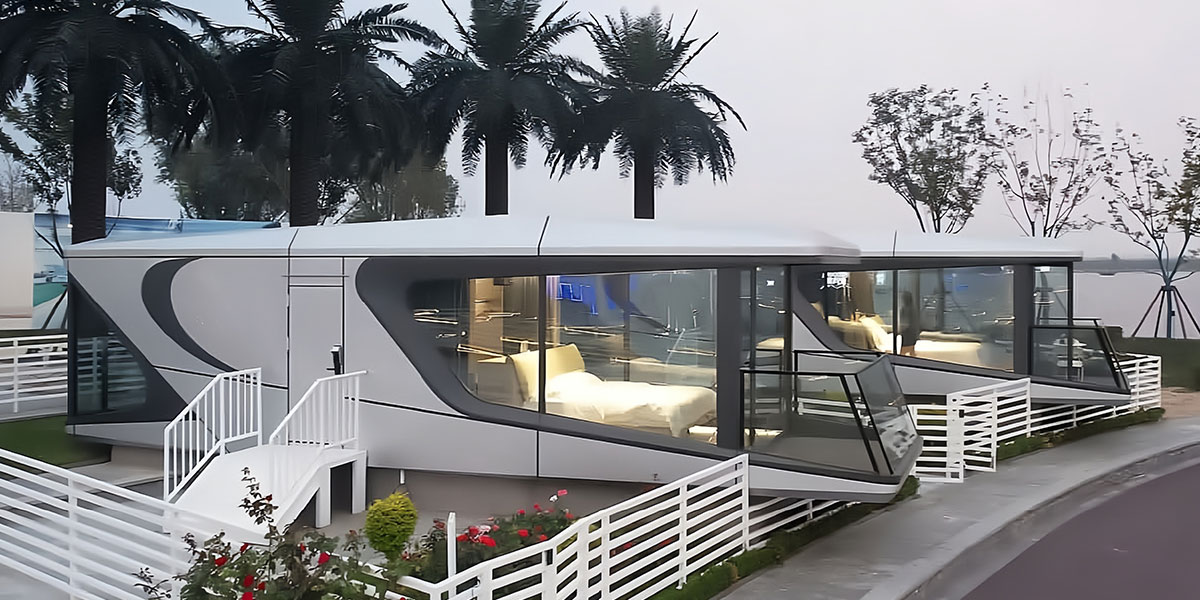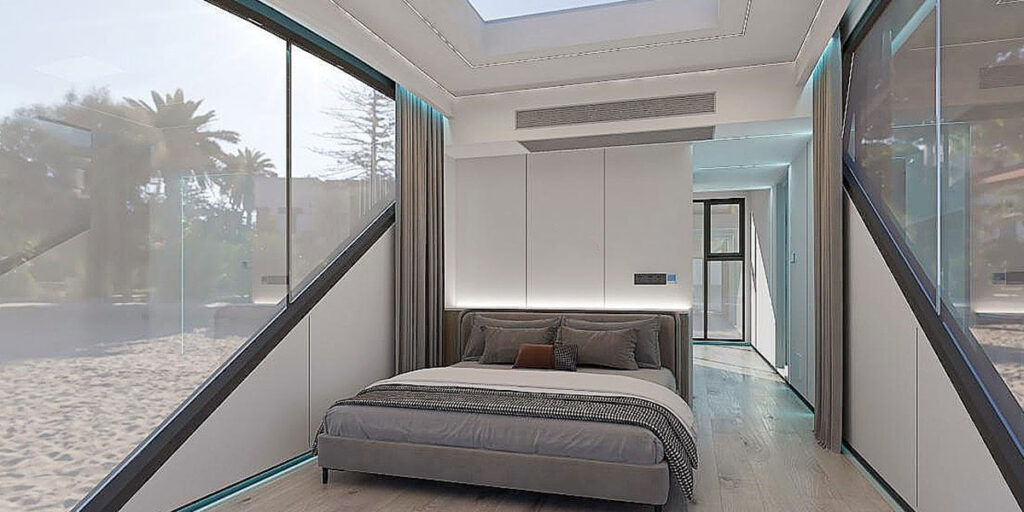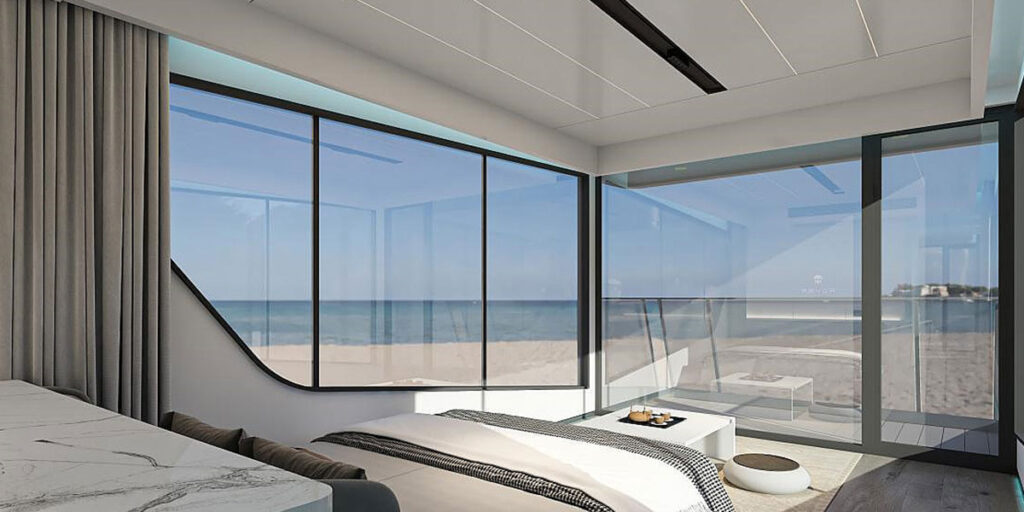
13 Jul How to Choose the Ideal 2-Bedroom Capsule House
Table of Contents
- 1 Key Takeaways
- 2 Identifying Your Needs for a 2-Bedroom Capsule House
- 3 Exploring Layout Options for Capsule House Living
- 4 Optimizing Space in a 2-Bedroom Capsule House
- 5 Budgeting for a 2-Bedroom Container Home
- 6 Ensuring Comfort and Privacy in Capsule House Living
- 7 Final Tips for Choosing the Right 2-Bedroom Capsule House
- 8 FAQ
Living in a 2 bedroom capsule house redefines small-space living. This innovative design perfectly blends space and comfort, making it ideal for urban environments. Emphasizing functionality, these homes incorporate technology to enhance daily living. Additionally, their energy-saving features not only reduce costs but also benefit the planet.
Key Takeaways
Think about your daily routines and what you need at home. This helps you create a space that fits your life.
Decide how you will use the second bedroom. It could be for guests, work, or hobbies. A flexible design lets you change it later.
Pick furniture that saves space. Items like sofa beds and folding tables keep your home neat and cozy.
Identifying Your Needs for a 2-Bedroom Capsule House
Assessing Your Lifestyle and Daily Habits
Before planning your 2-bedroom capsule house, think about your routines. Do you work at home? Do you like having guests or prefer quiet time? Your daily habits decide how the space should work for you.
For example, if you work remotely, one bedroom could be your office. If you’re a parent, the second bedroom might be a playroom or study for your kids. Consider what you do every day and what matters most to you.
Tip: List your daily activities and rank them by importance. This helps you figure out what features are most useful in your capsule house.
Determining the Purpose of the Second Bedroom
The second bedroom in a capsule house can serve many purposes. Its use depends on what you need. Will it be for guests, hobbies, or storage?
Here are some ideas:
Guest Room: Great for hosting visitors. Use modular furniture to save space.
Home Office: Perfect for working remotely, especially in small urban homes.
Hobby Room: Ideal for creative activities like art or music.
Storage Area: Useful for keeping things neat if you live minimally.
Flexible designs let you change the room as your needs change.
Considering Future Needs and Flexibility
Think about the future when picking a 2-bedroom capsule house. Your needs might change, so your home should adjust too. Whether you plan to grow your family or change your lifestyle, flexibility is key.
Why is flexibility important?
Cities are growing, and people want homes that adapt over time.
Eco-friendly trends focus on designs that meet future needs.
Capsule homes are popular because they can be easily changed for long-term use.
Note: Choose designs that let you change spaces easily. For instance, a modular second bedroom can switch from a guest room to a nursery or gym as needed.
Living in a capsule house means using space wisely and planning ahead. This ensures your home stays perfect for years to come.
Exploring Layout Options for Capsule House Living
Open vs. Closed Floor Plans
Deciding on open or closed floor plans depends on your needs. Open layouts connect spaces like the kitchen and living room. They feel roomy and are great for socializing or watching kids.
Closed layouts keep rooms separate, offering more privacy and quiet. These are better if you need focus or a peaceful workspace.
Tip: Open layouts fit minimalist styles. Closed layouts work for defined spaces.
Bedroom Placement and Accessibility
Bedroom location is important in a capsule house. Upstairs bedrooms, like in stacked designs, give privacy and outdoor space. Side-by-side bedrooms at opposite ends offer comfort and good flow.
L-shaped layouts separate bedrooms from shared areas for balance. They often include a courtyard, perfect for relaxing outside.
Best layouts for container homes:
Stacked containers for city living.
Side-by-side containers for more room.
Multi-Functional Spaces and Built-In Features
Smart design makes capsule houses work well. Multi-functional spaces save room and add flexibility. Foldable beds can turn into seats during the day. Built-in storage, like shelves under stairs, keeps things tidy.
Smart home tech adds even more. Automated lights, temperature control, and energy-saving systems make life easier. You can customize these features to fit your lifestyle.
Note: Multi-functional spaces are a must for making the most of two-bedroom layouts.
Optimizing Space in a 2-Bedroom Capsule House

Storage Solutions for Small Spaces
Living in a 2-bedroom capsule house means using space wisely. Smart storage ideas help you make the most of every corner.
Try built-in shelves or cabinets to use empty spaces better. Furniture with hidden storage, like beds with drawers or ottomans, keeps things tidy without needing extra room.
Technology can also inspire clever storage solutions. Methods like thin provisioning and deduplication save space by reducing what’s stored. Here’s a simple breakdown:
Technology | What It Does | Why It Helps |
|---|---|---|
Thin Provisioning | Uses storage only when needed. | Saves space by not reserving unused storage. |
Deduplication | Removes repeated data blocks. | Cuts down storage needs and speeds up setup. |
Zero Block Deduplication | Gets rid of empty data blocks. | Frees up all the space used by zero-filled blocks. |
Inline Deduplication | Shares one copy of repeated data blocks. | Makes storage faster and reduces how much is needed. |
These tech ideas show how to cut clutter and use space better. A neat, organized home feels more comfortable and works well for small living.
Tip: Pick furniture that doubles as storage. A coffee table with hidden compartments or a foldable desk can save space and add function.
Maximizing Vertical Space
In a small home, don’t forget to use the walls. Vertical areas can be just as useful as the floor.
Add shelves that reach up to the ceiling. Hang items like tools or utensils on hooks or pegboards. Loft beds are another smart choice—they free up space underneath for a desk, seating, or storage.
Use eco-friendly materials like bamboo or reclaimed wood for these additions. They look nice and support sustainable living trends.
Note: Add lights to brighten vertical spaces. LED strips or hanging lights can make these areas more inviting and functional.
Choosing Furniture That Fits the Space
Picking the right furniture is key in a 2-bedroom capsule house. Choose pieces that fit well and don’t overcrowd the space. Modular, compact, and multi-use furniture works best.
For example, a sofa bed can be a couch by day and a bed at night. A dining table with foldable sides can expand when guests visit. Lightweight furniture is easy to move and lets you change the layout as needed.
Custom furniture designed for small spaces is a great option. Many companies now offer eco-friendly pieces that fit your needs while being kind to the planet.
Pro Tip: Stick to one design style to make your home feel bigger. Neutral colors and simple patterns create a calm, open look.
Budgeting for a 2-Bedroom Container Home
Setting a Realistic Budget
Planning a budget for your 2-bedroom container home means knowing the costs. These homes are affordable, but careful planning is key. Prices usually range from $100,000 to $300,000. The cost depends on the design, layout, and features you pick.
Capsule homes are becoming more popular in crowded cities. Some governments offer discounts for energy-efficient homes, which can save money. But local rules might add costs, so check them before setting your budget.
Tip: Divide your budget into parts like building, furniture, and tech upgrades. This helps you focus on what’s most important.
Comparing Pre-Fabricated vs. Custom Designs
Choosing between prefab and custom designs depends on cost and style. Prefab homes are faster to build and cost less because of lower labor needs. They work well if you want a simple modular home.
Custom designs give you more options to match your lifestyle. But they cost more and take longer to finish. Architects and builders may add extra time and expenses.
Key Differences:
Custom designs are unique but more expensive.
Prefab is better for smaller budgets.
Factoring in Maintenance and Utility Costs
Think about future costs when planning your budget. Capsule homes are small and use strong materials, so upkeep is cheap. Adding solar panels or smart tech costs more at first but saves money later.
Utility bills depend on insulation and layout. Good airflow and sunlight lower energy use, saving money over time. Modular designs often include easy-to-maintain features, keeping your home simple and affordable.
Note: Spending on energy-saving systems now can cut bills and boost your home’s value.
Ensuring Comfort and Privacy in Capsule House Living

Soundproofing Between Rooms
Privacy is important in small spaces like a capsule house. Soundproofing helps keep rooms quiet and peaceful. Use materials like acoustic panels or insulated walls to block noise. This makes it easier to relax or focus without interruptions.
Soft materials, like cork or fabric-covered walls, absorb sound better. They also make the space feel cozy and calm. Choosing the right materials improves both comfort and privacy.
Feature | What It Does |
|---|---|
Studies personal space and how it affects comfort in homes. | |
Ceiling Height | Changes how open or cramped a space feels. |
Material Choice | Impacts sound control and touch, improving privacy and comfort. |
Nature Connection | Adds natural light and elements to boost mood and well-being. |
Tip: Add rugs or curtains to reduce noise and make rooms feel warmer.
Ventilation and Natural Light
Fresh air and sunlight make a capsule house feel bright and clean. Good ventilation removes pollutants and keeps the air healthy. Large windows or skylights bring in natural light, saving energy and lowering costs.
Capsule homes often focus on eco-friendly designs. Adding plants or open layouts connects you to nature. This reduces stress and makes the home more enjoyable.
Benefit | Why It Matters |
|---|---|
Less need for HVAC systems saves money and energy. | |
Reduced Artificial Lighting | Natural light cuts electricity use and improves comfort. |
Better Air Quality | Clean air supports health and clear thinking. |
Nature Connection | Natural elements lower stress and increase happiness. |
Note: Solar-powered ventilation systems are a smart, eco-friendly choice for your home.
Creating Cozy and Inviting Spaces
A capsule house can feel warm and welcoming with simple changes. Use soft lighting, like lamps or candles, to create a relaxing mood. Materials like wool or wood add texture and make the space feel cozy.
Natural items, such as plants or wooden furniture, bring life to the home. They also support eco-friendly living, which is popular today.
Ways to make your home cozy:
Use dimmable lights or candles for a soothing atmosphere.
Include plants and wood for a natural, calming vibe.
Pro Tip: Neutral colors and simple designs make small spaces feel bigger and more peaceful.
Final Tips for Choosing the Right 2-Bedroom Capsule House
Visiting Model Homes or Virtual Tours
Seeing a capsule house in person or online helps a lot. You can explore the layout and imagine living there. Walking through rooms shows how the space flows and fits your needs.
Virtual tours are great if you’re busy or live far away. They let you check out designs from home. Many builders offer tours where you can zoom in or switch layouts.
Tip: Write down what you like or dislike during tours. This makes it easier to choose later.
Consulting with Professionals or Designers
Experts can save time and improve your choices. Designers know how to make spaces work better for your lifestyle. They can suggest smart ideas you might not think of.
For example, Marilisa Barbieri’s advice has helped many people. Her tips have improved projects and made homes more functional. Designers like her can solve problems and add style to your home.
Pro Tip: Tell the designer your needs and ideas. Clear communication helps them create the perfect design for you.
Trusting Your Instincts and Prioritizing What Matters Most
Your capsule house should feel right for you. If something doesn’t fit, don’t choose it. Focus on what’s most important, like privacy, hobbies, or eco-friendly features.
You can customize the design to match your preferences. Make sure every part of your home works for your lifestyle. This is your space, so it should reflect who you are.
Note: Take your time to decide. Don’t rush—choose what makes you happy.
Picking the best 2-bedroom capsule house can change your life. Matching its design to your needs makes it feel like home. Spend time looking at different choices before deciding. A good capsule house can boost your comfort and energy daily. With smart planning, it becomes a cozy, useful space that adapts to your future.
FAQ
How is a capsule house different from regular homes?
Capsule houses are small and use space wisely. They have smart designs and multi-use features, perfect for city living.
Can I change a capsule house to fit my needs?
Yes, you can adjust capsule houses easily. Change layouts, furniture, and features to match your daily life and future plans.
Are capsule houses good for the environment?
Yes, they are eco-friendly. Capsule houses use green materials, save energy, and include smart tech to lower costs and help the planet.



